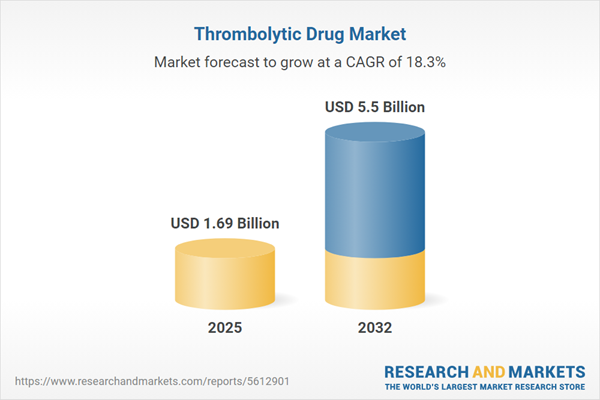Speak directly to the analyst to clarify any post sales queries you may have.
Senior leaders in the pharmaceutical sector face a dynamic thrombolytic drug market shaped by advances in clinical technology, regulation, and operational strategies. Adapting to shifting care standards and supply challenges requires strategic agility and an informed approach to market shifts.
Market Snapshot: Thrombolytic Drug Market Growth and Trends
Between 2024 and 2025, the global thrombolytic drug market is forecast to grow at a compound annual growth rate (CAGR) of 18.31%. This robust trajectory is driven by escalating demand for advanced therapies targeting acute vascular incidents. Healthcare providers are modernizing with new clinical protocols while aligning with evolving regulatory standards. Multinational and regional manufacturers are expanding into diverse markets, enabling organizations to respond efficiently to changing requirements and competitive pressures. Growth is further influenced by pressures on supply chain resilience and a focus on scalable deployment of new solutions.
Scope & Segmentation of the Thrombolytic Drug Market
- Drug Class: Streptokinase and advanced tissue plasminogen activators—including alteplase, reteplase, tenecteplase, and urokinase—make up core therapeutic categories. These agents provide both immediate and sustained intervention options, shaping evolving clinical practices and supporting compliance-focused innovation among manufacturers.
- Indication: Thrombolytic drugs address major conditions such as myocardial infarction, deep vein thrombosis, ischemic stroke, and pulmonary embolism. Their versatility accommodates a broad range of treatment scenarios across acute and specialized care settings.
- Route of Administration: Intra-arterial and intravenous options deliver procedural flexibility, enabling clinicians to manage acute cases with speed and efficacy. Widespread adoption in emergency care supports diverse facility types and operational models.
- End User: Hospitals, emergency medical providers, and ambulatory centers set demand priorities by sourcing therapies that enhance patient management, optimize outcomes, and support integrated care pathways.
- Patient Group: Dosing strategies and innovative formulations continue to advance, supporting effective and safer care for both adult and pediatric patients. Personalized approaches respond to complex presentations in acute therapy settings.
- Geographic Coverage: The market footprint encompasses the Americas, Europe, Middle East, Africa, and Asia-Pacific. Each region features distinct regulatory landscapes, adoption trends, and business models, contributing unique opportunities for market expansion and partnership development.
- Company Coverage: Global leaders such as F. Hoffmann-La Roche AG, Boehringer Ingelheim International GmbH, Sanofi S.A., Teva Pharmaceutical Industries Limited, Sandoz International GmbH, and Sun Pharmaceutical Industries Limited drive international access and innovation. Regional enterprises—including Cipla Limited, Apotex Inc., Cadila Healthcare Limited, and Biocon Limited—reinforce localized supply chains and strategic market reach through partnerships and distribution networks.
Thrombolytic Drug Market: Key Takeaways for Decision-Makers
- Advancements in peptide engineering and delivery techniques are increasing patient safety and broadening the clinical utility of thrombolytic treatments in both acute and maintenance care.
- Expansion of biosimilars is reshaping procurement strategies, introducing greater market competition and enhancing opportunities to optimize costs and supplier engagement.
- Simplified and streamlined regulatory pathways enable timely interactions with clinical stakeholders, supporting faster access and ongoing compliance with evolving guidelines.
- The proliferation of mobile stroke units and direct-to-site diagnostic tools is increasing demand for agile distribution and logistics services across both centralized and decentralized healthcare models.
- Enhanced market segmentation by product, indication, and therapy setting enables commercial teams to refine go-to-market strategies in alignment with emerging clinical priorities and operational needs.
- Collaboration among logistics partners, distributors, and pharmaceutical manufacturers is strengthening continuity within supply chains and improving risk management in global delivery environments.
Examining the Tariff Impact on Supply and Pricing
Recent changes in United States tariff policy are prompting organizations to reassess sourcing and pricing strategies in the thrombolytic drug sector. To mitigate trade-related risks, companies are investing in domestic production, regional alliances, and more diversified supplier networks. These strategic shifts fortify supply stability, manage costs, and build readiness for further regulatory adjustments and evolving market conditions.
Methodology & Data Sources Underpinning this Report
This analysis integrates primary insights from structured interviews with industry leaders and clinical stakeholders, validated through quantitative data and peer-reviewed literature. Regulatory reports and proprietary analytic tools support evidence-based recommendations tailored for executive perspectives.
Why This Report Matters for Senior Decision-Makers
- Enables dynamic resource planning by providing actionable market intelligence and supporting responsive, long-term positioning.
- Delivers strategic insights to enhance supplier partnerships, streamline operations, and develop regionally targeted growth initiatives.
- Supports adoption of commercial models that reflect current buyer requirements, boosting operational efficiencies across multiple healthcare delivery contexts.
Conclusion
Long-term success in the thrombolytic drug market depends on sustained clinical innovation, adaptive regulatory strategies, and strengthened supply chain resilience. By prioritizing these areas, organizations can achieve both commercial and healthcare objectives in an evolving landscape.
Additional Product Information:
- Purchase of this report includes 1 year online access with quarterly updates.
- This report can be updated on request. Please contact our Customer Experience team using the Ask a Question widget on our website.
Table of Contents
3. Executive Summary
4. Market Overview
7. Cumulative Impact of Artificial Intelligence 2025
Companies Mentioned
The companies profiled in this Thrombolytic Drug market report include:- F. Hoffmann-La Roche AG
- Boehringer Ingelheim International GmbH
- Sanofi S.A.
- Teva Pharmaceutical Industries Limited
- Sandoz International GmbH
- Sun Pharmaceutical Industries Limited
- Cipla Limited
- Apotex Inc.
- Cadila Healthcare Limited
- Biocon Limited
Table Information
| Report Attribute | Details |
|---|---|
| No. of Pages | 192 |
| Published | November 2025 |
| Forecast Period | 2025 - 2032 |
| Estimated Market Value ( USD | $ 1.69 Billion |
| Forecasted Market Value ( USD | $ 5.5 Billion |
| Compound Annual Growth Rate | 18.3% |
| Regions Covered | Global |
| No. of Companies Mentioned | 11 |









